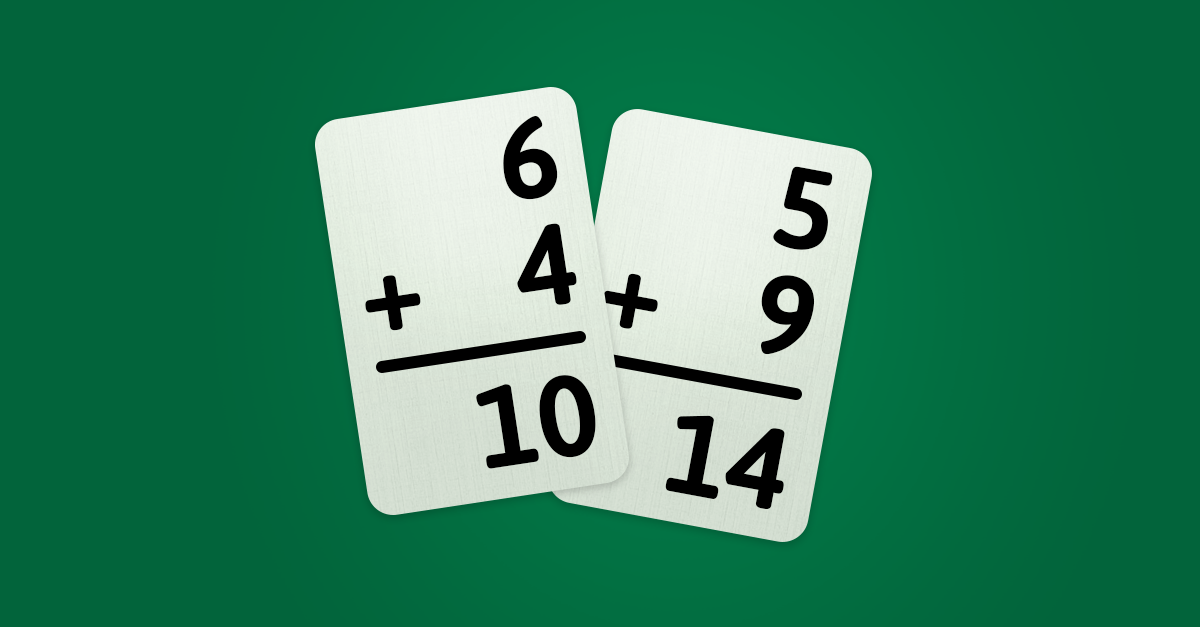Math Flash Cards: Are You Using Them the Wrong Way?

Visit any homeschool household and look for the “tools of our trade” as homeschool moms, and you are going to find math flash cards. They are probably the single most used tool in a homeschool mom’s tool belt, and I am about to tell you that you’re misusing them.
How I Used Flash Cards the Wrong Way
Yes, I am poster child for how to use flash cards the wrong way.
Allow me to paint a picture for you: I sit down with my child – usually across a table (already putting a physical barrier between us…) – and I hold up a flash card that shows 6 + 4. I say to my child, “Six plus four is…?” and expectantly grin.
My child dutifully says, “Six plus four equals ten.” I enthusiastically say, “Excellent!” And then I hold up a flash card that show 5 + 9, and my student hesitates; in a wink of an eye I say, in likely what sounds like a whiny voice, “Aw, come on! You knew this yesterday!!” and waggle the flash card at them.
Boom.
In a flash I have inadvertently and completely derailed the process I’m trying to accomplish. Has this ever happened in your home? Flash card learning is going along swimmingly, until you encounter one fact that your student stumbles on, and then, from that point forward, the whole thing descends into a rough deal.
The Problem With Flash Cards
What? What happened here? Quite by accident, I derailed my child’s learning train by introducing stress into the learning equation. Specifically, what happened to my child is that their learning was literally hijacked.
I have to give much credit to Dr. Karen Holinga for showing me what I was doing in error. Research tells us that when stress enters a learning situation, learning stops.
There’s nothing we can do to combat it because it is a physiological response to the perceived stress. Dr. Holinga calls it an amygdala hijack, which means that learning is temporarily interrupted until the stress dissipates. This biological cascade cannot be prevented. In the presence of stress, the amygdala, a small part of the brain, actually shuts learning down.
I was an ardent flash card proponent and used them in conjunction with other methods to help teach facts to my children. However, I must confess that my fictional scenario was not very fictional in my household. It happened – a lot. The minute my child perceived that I was less than happy with their performance and stress entered the equation, their learning stopped.
How to Use Flash Cards Better
So what would be an effective way to teach math facts without creating a stressful environment?
Remember, memorizing math facts is like reading without sounding out words. It makes the whole process of mathematics more doable. My colleagues and I share all sorts of ways to internalize those facts without the stress of flash cards.
Today I want to share with you two of my favorites:
With a younger child, purchase a beach ball; it needs to be at least 18 inches in diameter. Then take a permanent marker and write numbers all over the ball so that, as the ball is thrown and then caught with two hands, the child’s hands will be on two numbers. The game “number catch” goes something like this: toss the ball to your child, and where their two hands land, have them use those numbers in the corresponding math fact (example: “Six plus six equals twelve”) Then have them toss the ball back to you, and you do the same. This incorporates more than one sense, and keeps the learning fun.
With an older child, you can use a deck of cards to play “Fact War”. Split the deck in half equally between the two of you. You throw down a 6 and your child throws down a 7; 6 x 7 = 42. The first one to answer correctly wins that pile. You may need to grant grace in the beginning, but it won’t be long before they are really playing in earnest. Star with the face cards as ‘10’ – you can become more creative as their proficiency increases. Then Jacks can become 11, Kings can become 12, and so on.
Did I burn all of the flash cards at my house? Nope. In fact, they are all over the place. But I never ask more than three facts in a row and usually do it as my children are on the way to do something else. For example, my youngest says he is on his way out to the trampoline; I may say, “Ok, but answer me three first,” and ask him three random facts. He will laugh, answer, and then move on out the door!
The rest of the story?
All six of my children are proficient with their math facts, but, interestingly enough, my youngest, with whom I used the fewest flash cards, learned his facts the most quickly and seemed to be the most cheerful in the process. I don’t think it was a coincidence. I wish you a stress-free and joyful learning experience with your children, and I earnestly hope you don’t hijack the process with those flash cards!
We Are Here to Help
If you have questions about teaching math, we are here to help!
Get in Touch